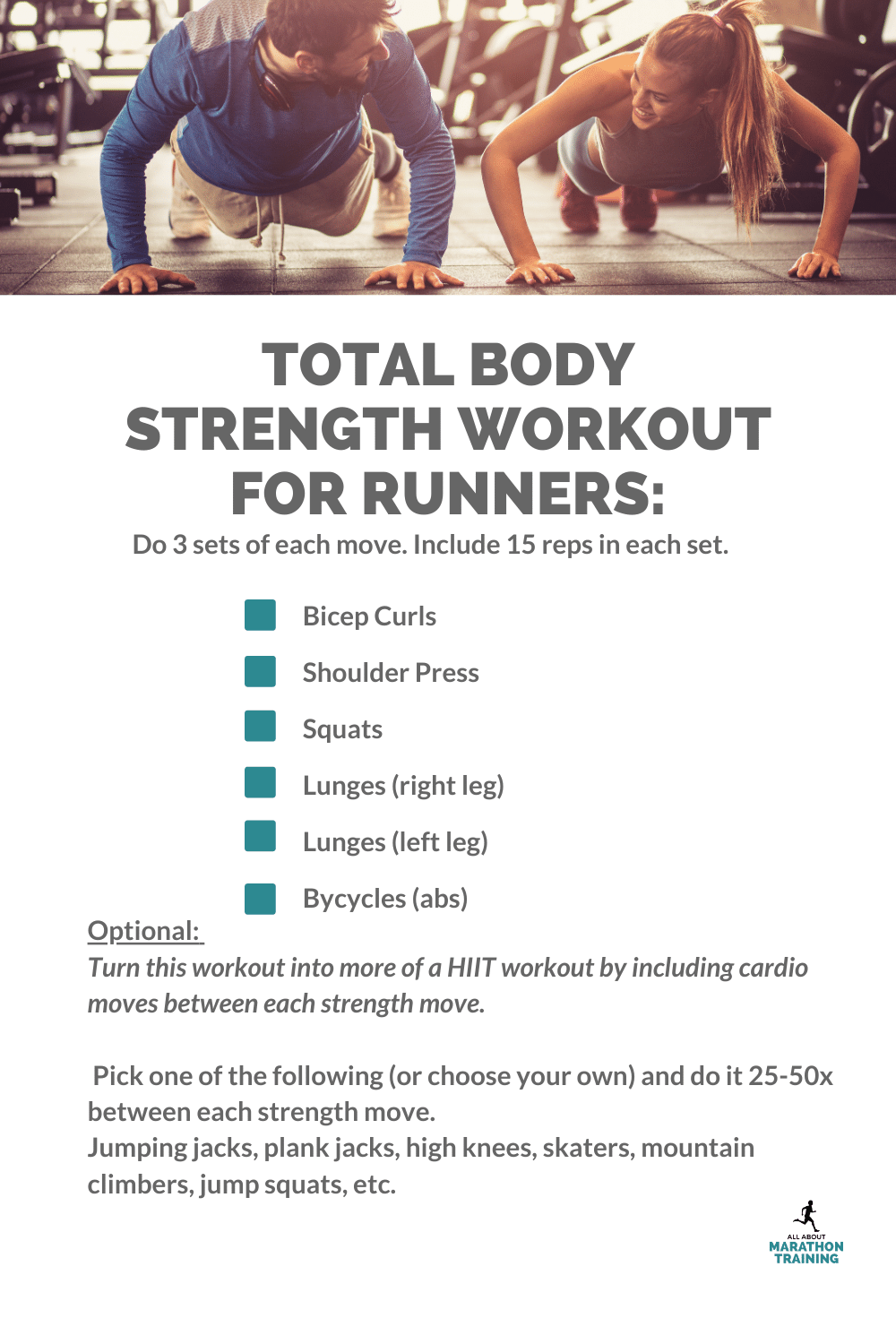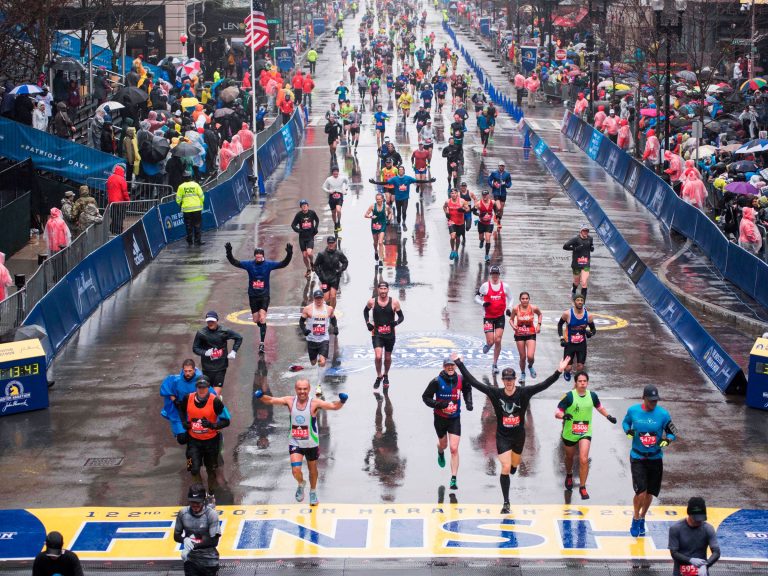3 Full Body Workouts For Runners
Boost your running performance with these three full body workouts: HIIT, strength training, and yoga. Engaging in a variety of exercises will help runners improve strength, flexibility, and overall fitness level.
Whether you’re a beginner or a seasoned runner, incorporating these workouts into your routine can help prevent injury and enhance your running performance. HIIT workouts are great for improving cardiovascular fitness and burning calories, strength training enhances muscle strength and stability, while yoga promotes flexibility and mental focus.
By combining these workouts, you can become a stronger and more well-rounded runner.

Credit: www.pinterest.com
The Importance Of Full Body Workouts For Runners
As a runner, it’s crucial to focus not only on your lower body strength but also on your overall body conditioning. Integrating full body workouts into your training routine can significantly enhance your performance, prevent injuries, and improve your overall fitness. Let’s delve into the reasons why full body workouts are indispensable for runners and explore the benefits they offer.
Why Runners Need Full Body Workouts
While running primarily engages the lower body, neglecting the upper body and core can lead to muscle imbalances and compromised posture. Incorporating full body workouts helps in achieving a balanced musculature, which is vital for running efficiency and injury prevention. Strengthening the upper body and core aids in maintaining proper form, improving stability, and reducing fatigue during long runs.
Benefits Of Full Body Workouts For Runners
- Enhanced Strength: Full body workouts contribute to overall body strength, which can lead to improved running performance and endurance.
- Injury Prevention: By targeting the entire body, these workouts help in strengthening muscles, tendons, and ligaments, lowering the risk of running-related injuries.
- Improved Stability and Balance: Engaging in full body workouts supports better balance and stability, crucial for maintaining proper running form and reducing the chance of falls or missteps.
- Increased Flexibility: Including exercises that promote flexibility in full body workouts can aid in enhancing the range of motion and reducing muscle tightness, benefiting runners’ overall mobility.
- Mental Focus and Endurance: Full body workouts demand mental perseverance, which can translate to enhanced mental stamina during runs and races.

Credit: www.all-about-marathon-training.com
1. Plyometric Workout Routine
Plyometric training is a high-intensity workout that focuses on explosive movements to enhance power and speed.
What Is Plyometric Training?
Plyometric training involves quick, powerful movements that target fast-twitch muscle fibers, improving overall athletic performance.
Key Plyometric Exercises For Runners
- Box Jumps: Jump onto a sturdy box, landing softly on the balls of your feet.
- Burpees: Combining a squat, plank, and jump, burpees help build endurance and explosive power.
- Jump Squats: Perform squats and explode upwards into a jump, engaging your lower body muscles.
By incorporating plyometric exercises into your routine, runners can boost their speed, agility, and muscular strength.
2. Strength Training Routine
Strength Training Routine:
Why Strength Training Is Essential For Runners
Strength training enhances muscle mass and power for runners.
Recommended Strength Training Exercises For Runners
- Squats: Engage major leg muscles.
- Lunges: Improve balance and strength.
- Planks: Strengthen core muscles for stability.
3. Yoga And Mobility Routine
3. Yoga and Mobility Routine
Yoga and mobility routines are vital for runners to enhance flexibility, improve mobility, and prevent injuries. By incorporating yoga into their training regimen, runners can promote balance, strength, and mental focus. Here are the top yoga poses for runners and how yoga can benefit their overall performance:
How Yoga Helps Runners
Yoga helps runners by targeting tight muscles, enhancing flexibility, and improving overall body alignment. It also aids in relieving stress and promoting mental clarity, essential for a runner’s focus and endurance during training and races.
Top Yoga Poses For Runners
Here are the essential yoga poses that benefit runners:
- Downward-Facing Dog Pose: Stretches and strengthens the hamstrings, calves, and arches of the feet.
- Warrior Pose: Helps build lower body strength and opens the hips, crucial for runners’ agility and stability.
- Pigeon Pose: Releases tension in the hips and stretches the hip flexors and glutes, aiding in preventing common running injuries.
- Tree Pose: Enhances balance and strengthens the ankles, promoting stability during runs.
- Child’s Pose: Provides a gentle stretch for the lower back, hips, and thighs, aiding in relaxation and recovery.
Tips For Incorporating Full Body Workouts Into Your Running Routine
When it comes to running, it’s easy to focus solely on your lower body. But incorporating full body workouts into your running routine is essential for improving overall strength, stability, and injury prevention. In this article, we will explore three effective full body workouts specifically tailored for runners. But before diving into the routines, let’s discuss some important tips for seamlessly integrating these workouts into your running schedule.
Finding The Right Balance
When incorporating full body workouts into your running routine, finding the right balance is key. You don’t want to overexert your muscles and hinder your running progress, nor do you want to neglect important muscle groups. Striking a balance between running and full body workouts is crucial for optimal performance.
One way to achieve this balance is to schedule your full body workouts strategically throughout the week. By spacing them out, you allow your muscles ample time to recover and adapt. A good starting point is to aim for two to three full body workout sessions per week, with at least one rest day in between each session. This will ensure that your muscles are challenged and stimulated without sacrificing recovery time.
Scheduling Full Body Workouts
When scheduling your full body workouts, it’s important to consider your running schedule and goals. If you have a particularly demanding week of running ahead, it may be wise to prioritize rest and recovery over intense full body workouts. On the other hand, if you have lighter running days or a day off, it presents an opportune time to incorporate a more challenging full body workout.
| Day | Activity |
|---|---|
| Monday | Rest day or light running |
| Tuesday | Full body workout |
| Wednesday | Running |
| Thursday | Rest day or light running |
| Friday | Full body workout |
| Saturday | Long run or challenging run |
| Sunday | Rest day |
This sample schedule demonstrates how you can integrate full body workouts with your running routine. By strategically placing your workouts on days when you have a lighter running load, you ensure that your muscles are engaged while still allowing for adequate recovery time.
Modifying Workouts For Different Running Levels
Not all runners are at the same level, and it’s important to modify workouts accordingly. Whether you’re a beginner or an experienced runner, there are ways to adapt full body workouts to suit your current fitness level.
- Beginners can start with bodyweight exercises such as squats, lunges, and planks. Focus on mastering proper form and gradually increasing the number of repetitions and sets as you build strength.
- Intermediate runners can incorporate resistance bands or dumbbells to add additional resistance to their exercises. This will challenge the muscles further and promote greater strength gains.
- Advanced runners can opt for more advanced movements such as deadlifts, pull-ups, and kettlebell swings. These exercises work multiple muscle groups simultaneously and provide a greater challenge for those seeking to take their training to the next level.
Remember, it’s essential to listen to your body and progress at your own pace. Pushing beyond your limits too soon can lead to injury and setbacks in your running journey.

Credit: runninforsweets.com
Frequently Asked Questions For 3 Full Body Workouts For Runners
What Are The Benefits Of Full Body Workouts For Runners?
Full body workouts for runners help improve overall strength, flexibility, endurance, and prevent injury.
How Often Should Runners Include Full Body Workouts In Their Routine?
Including full body workouts in your routine 2-3 times a week can help maximize the benefits and enhance running performance.
What Are Some Effective Full Body Exercises For Runners?
Some effective full body exercises for runners include squats, lunges, planks, push-ups, and mountain climbers. These target multiple muscle groups and contribute to overall fitness.
Conclusion
Incorporating full-body workouts into your running routine can improve your overall strength and performance. These three workouts are designed to target multiple muscle groups, enhance your endurance, and prevent injuries. By focusing on strength training, you can become a more efficient and resilient runner, ultimately reaching your full potential on the track or trail.




